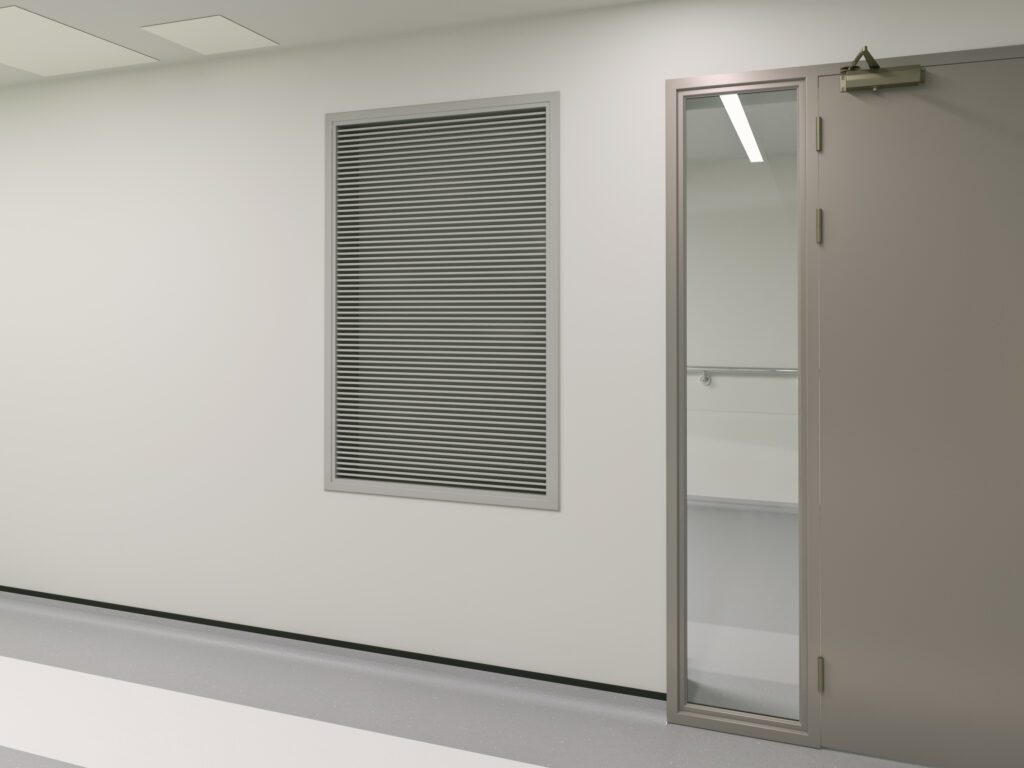Fire safety is often associated with alarms, sprinklers, and extinguishers. A frequently overlooked yet essential component of smoke ventilation systems are the Smoke Control Dampers.
These devices are engineered to regulate the movement of smoke during a fire, allowing smoke extract and if required inlet air from a single compartment, but when closed, needs to resist the passage of fire and smoke, maintaining compartmentation. By compartmentalizing and extracting smoke, Smoke Control Dampers play a vital role in protecting occupants, enabling safe egress, firefighters access and limiting damage to property.
What Are Smoke Control Dampers and How Do They Work?
Smoke control dampers are specialised components engineered to manage the movement of smoke during a fire. Unlike standard fire dampers that merely close to block smoke from spreading through ductwork, these dampers actively open or close to direct smoke along controlled pathways. They form a critical part of engineered smoke control systems, ensuring stairwells, lobbies, corridors, and evacuation routes remain clear.
At Teal Products, our Smoke Control Dampers are designed to integrate seamlessly within advanced smoke control systems, optimising smoke management, maintaining safe egress routes, and ensuring full compliance with fire safety standards. View the video on the SV-W-D5 Smoke Damper below to find out more.
The Hidden Danger: Smoke Inhalation
It’s a common misconception that fire itself is the biggest threat during a blaze. Smoke inhalation is the leading cause of fire-related deaths, accounting for more fatalities than burns. Smoke is toxic, blinding, and fast-moving, making escape nearly impossible if it fills exit pathways.
That’s where smoke control dampers prove their worth. By containing and directing smoke, they help ensure that people can safely reach exits before conditions become deadly.
The Different Damper Types
Smoke dampers and fire dampers serve different, specific functions:
- Fire Dampers: Automatically close when exposed to elevated temperatures, preventing flames from spreading through ductwork.
- Fire & Smoke Dampers: Meets the same performance of the fire damper, but in addition resists the spread of smoke, by achieving a lower leakage rate.
- Smoke Control Dampers: Operate as part of an integrated smoke management system, actively regulating airflow to block, allow, or redirect smoke, thereby maintaining tenable escape routes.
In summary, fire dampers stop fire spreading, and fire & smoke stop fire and smoke spreading and smoke control dampers can stop fire and smoke spreading but also strategically manage smoke movement to protect occupants and support safe evacuation.
Maintenance and Inspection: Staying Code-Compliant
Ensuring the functionality of smoke control dampers is critical for occupant safety and regulatory compliance. In the UK, adherence to regulations is mandatory for all buildings, particularly those classified high risk buildings (HRB).
Regulatory Framework, Standards & Guides
- Regulatory Reform (Fire Safety) Order 2005: This legislation mandates that life-safety systems, such as smoke control systems, must be maintained and tested “as often as necessary” to prevent risks of death or serious injury in the event of a fire.
- Fire Safety (England) Regulations 2022: Builds on the FSO, for high-rise buildings, the ‘Responsible Person’ legally must ensure that essential firefighting equipment, including smoke control systems, are checked monthly & must advise local fire and rescue services of any faults that cannot be rectified within 24 hours. Please see Fire Safety (England) Regulations 2022.
- BS 9991:2024 & BS 9999:2017: For residential and commercial buildings respectively. Within Annex I of each of these British Standard provides guidance on Routine inspection and maintenance of fire safety installations.
- Smoke Control Association (SCA) Guidance on Maintenance of Smoke Control Equipment: Similar to the British Standard but adding in an extensive six-month testing and maintenance. It also, gives definitions for Nominated Person, Competent Person, Competent Maintainer and Certified Organisation e.g. KIWA/IFCC SDI 19 scheme for maintenance of smoke control systems.
Maintenance Requirements Summary
Daily
- Inspection of control panels, indicate normal operation.
- Faults logged, appropriate action taken.
Weekly checks
- Conduct operational tests to ensure equipment such as smoke control dampers, AOVs, and fans are functioning correctly.
Monthly inspections
- Perform inspections of rooftop equipment, checking for debris, corrosion, wear, and signs of tampering or vermin.
- Simulate primary power failure, testing backup power devices and batteries.
Three-monthly
- Ensure actuation of all zones.
Six-monthly
- More extensive testing and maintenance, run through full cause & effects.
- If applicable, confirm flow rates, check environmental functions, check maintenance records of ATS, UPS, or back-up generator.
Annual Testing
- Full performance check, same as six-monthly but also verification versus original design.
Documentation and Compliance
- Maintenance Logbooks: Maintain detailed records of all inspections, tests, and maintenance activities, including dates, findings, and corrective actions taken.
- Access and Visibility: Ensure that all dampers are easily accessible for inspection and maintenance. Obstructed or hidden dampers may not function correctly during an emergency and can lead to non-compliance.
- Competency: Employ individuals or qualified contractors with appropriate training and certification to perform inspection and maintenance tasks, ensuring adherence to industry standards and regulations. Please see SCA Guidance on Maintenance of Smoke Control Equipment for further information.
- Building Safety Act 2022: Introduced the legal requirement for a “Golden Thread” of information for higher-risk buildings (residential blocks >18m). Must be digital, secure, accurate, up to date, and accessible to those who need it.
Need Help with Your Smoke Control Dampers?
Since 2000, Teal Products has been providing trusted smoke ventilation solutions. From AOV windows to bespoke smoke control systems, our team can help you find the perfect solution.
